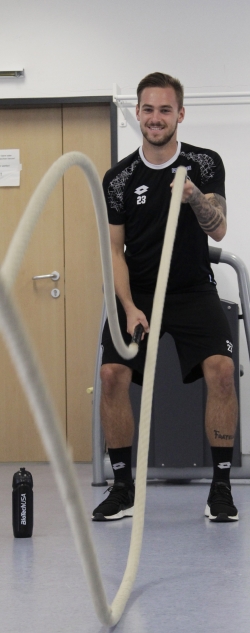
5 effective strength training tips for footballers

What do football players need? Strong, explosive leg muscles, strong core muscles to provide them stability and the limbs economic movement, coordination, muscles which endure long-term stress, fast recovery. Let’s see some exercises which make excellent additions to a footballer’s training plan!
Improving your core muscles and coordination
A BOSU ball is a training device used for various useful exercises. One side of the device is a hemisphere, the other is hard and flat. It’s not only useful for muscle training; it also excellently improves coordination, even combined with jumps. This time, the hemisphere faces the floor and the flat platform faces up. Stand on the flat side of the BOSU ball with one leg, and keeping your balance, raise the other leg backwards and tilt your upper body forward. Keep your trunk and the raised leg in line all the time, and when you’ve reached a horizontal position, straighten up and start the next repetition. It’s a great exercise that targets the hamstrings, as well as the calf and the trunk. More advanced users can also combine the exercise with ball exercises.
 Leg training with squats and jumps
Leg training with squats and jumps
We’ll continue with the device described in the previous exercise. We’re targeting the leg muscles again. Turn the BOSU ball with the hemisphere facing up. Jump on the hemisphere, stabilise your balance and then do a deep squat. Gain momentum while standing up from the squat, jump up in the air and make a 90-degree turn. Stabilise again, do a squat, and then jump up from the squat and turn. Advanced user can, again, combine the exercise with various ball exercises, such as catches, throws or sprints and slaloms started from the end position.
Strength and endurance exercise at the same time
Sprint, complete with a resistance band, is an exercise that improves leg strength and endurance. The resistance band should be worn like a harness, but you may as well simply put it around your waist. The stronger and more skilled the athlete, the thicker resistance band you should choose, otherwise you can run after him or her. As a trainer, your task is to hold the athlete back, to let him or her sprint against the resistance to the given finish line or within the given time.
Arm and core training with a rope
The rope wave exercise targets core muscles and endurance. While training your arms, the jumps dynamically work your leg muscles. We usually work with a time limit, waving the ropes for 30-60 seconds at various paces, separately or with both arms. For jumps, we normally work with both arms and insert a jump at every particular wave, e.g. every second wave.
Extra core muscle training with a GFlex belt
Planks are among the best core muscle exercises. If your core muscles are strong, your limbs can work more economically. Hook your ankle into the GFlex belt to make the exercise more unstable. In a push-up position and without moving your hip, lift one arm from the floor, e.g. by touching your other inner elbow, and hold this position for about 15-20 seconds (advanced athletes) and then switch sides. Pay attention to the proper body position, holding your waist fixed and tilting your pelvis back (the pubic bone moves forward). Do 2-5 reps.
Enjoy your training.
Dóra Nagy
Personal trainer, BioTechUSA training and nutrition expert, IWI trainer